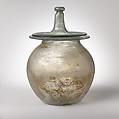Glass cinerary urn with lid
Urn: Translucent pale blue green.
Broad, horizontal rim, with rounded tubular edge made by folding out, down, and in; short, concave neck; ovoid body; deep concave bottom.
Intact; some bubbles, a few very large; dulling, limy encrustation, faint iridescence, and patchy brown weathering on exterior, slight dulling on interior.
Lid: Translucent blue green.
Thickened horizontal rim, with slight downward and inverted lip and beveled outer edge; horizontal side with concentric ridge near rim and broad concave band within on upper surface; hollow stem, tapering upwards to slightly flattened circular knob; small, tooled indent on top and tiny hole in center of knob.
Intact, except for small chip in rim; many bubbles, some very large; slight dulling, iridescence, and creamy brown weathering.
The lid is slightly smaller than the rim of the urn but sits evenly on inner edge of rim and mouth.
In addition to handled vessels, large plain jars were often used as cremation urns, which may explain why they are more commonly found in Italy and the western provinces than in the Greek East.
This image cannot be enlarged, viewed at full screen, or downloaded.

